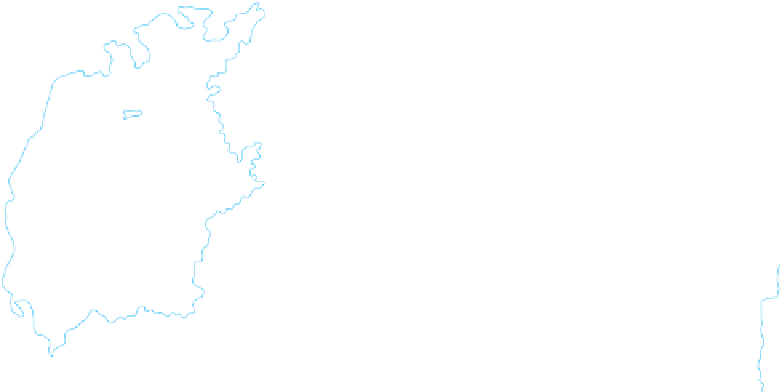Geography Reference
In-Depth Information
Delta
KAZAKHSTAN
KAZAKHSTAN
KAZAKHSTAN
UZBEKISTAN
UZBEKISTAN
UZBEKISTAN
0
100
160 Km
100 Miles
0
100
160 Km
100 Miles
0
100
160 Km
100 Miles
0
0
0
A
B
C
Aral Sea, mid-1960s
Aral Sea, early 2000s
Aral Sea, 2011
Figure 13.9
The Aral Sea.
Affected by climatic cycles and affl icted by human interference, the Aral Sea
on the border of Kazakhstan and Uzbekistan has shrunk. In a quarter of a century, it lost three-
quarters of its surface area.
© E. H. Fouberg, A. B. Murphy, H. J. de Blij, and John Wiley & Sons, Inc.
distribution is sustained through the
hydrologic cycle
,
where water from oceans, lakes, soil, rivers, and veg-
etation evaporates, condenses, and then precipitates on
landmasses. The precipitation infi ltrates and recharges
groundwater or runs off into lakes, rivers, and oceans
(Fig. 13.10). Physical geographer Jamie Linton questions
the utility of any model of the water cycle that does not
take into account the role of humans and culture, sug-
gesting that by “representing water as a constant, cycli-
cal fl ow, the hydrologic cycle establishes a norm that is at
odds with the hydrological reality of much of the world”
(Linton 2008, 639).
Linton argues that the hydrologic cycle does not
take into account the norms of water in arid regions of the
world, and it also assumes water cycles in a predictable, lin-
ear fashion. The amount of water cycling through is not
a constant. For instance, landcover changes how much
water is in the cycle. In the global south, Linton, contends,
forests “can actually promote
Mountain and Sierra Nevada snows feed the Colorado
River and the aquifers that irrigate the California Central
Valley. Aqueducts snake their way across the desert to
urban communities. None of this has slowed the popu-
lation's move to the Sun Belt (see Chapter 12), and the
water situation there is becoming problematic. In coastal
eastern Spain, low water pressure in city pipes sometimes
deprive the upper fl oors of high-rise buildings of water.
In Southwest Asia and the Arabian Peninsula, grow-
ing populations strain ancient water supply systems and
desalinization plants are a necessity. Water plays a role in
regional confl icts in places including the Darfur region
of Sudan.
When relations between countries and peoples are
problematic, disputes over water can make them even
worse. As populations grow and as demand for water rises,
fears of future shortages intensify.
evapotranspiration at rates
much higher than for short crops,” which has “the overall
effect of
reducing
the quantity of water available for runoff
or groundwater recharge” (Linton 2008, 643).
Instead of the hydrologic cycle, Linton advocates
thinking of water as a system rather than a cycle (Fig. 13.11).
He defi nes the water system as the “integration of physi-
cal, biological, biogeochemical, and human components”
of the global water system.
Water and Politics in the Middle East
Water supply is a particularly diffi cult problem affecting
relations among Israel and its neighbors. With 7.7 mil-
lion people, Israel annually consumes nearly three times
as much water as Jordan, the West Bank Palestinian areas,
and Gaza combined (total population: over 7 million). As
much as half of Israel's water comes from sources outside
the Israeli state.
The key sources of water for the entire area are
the Jordan River and an aquifer beneath the West Bank.
When Israel captured the Golan Heights from Syria and
the West Bank from Jordan during the 1967 war, it gained
control over both of these sources, including the Jordan
Water Security
Throughout the world, people have come to depend on
water sources whose future capacity is uncertain. Rocky





























































































